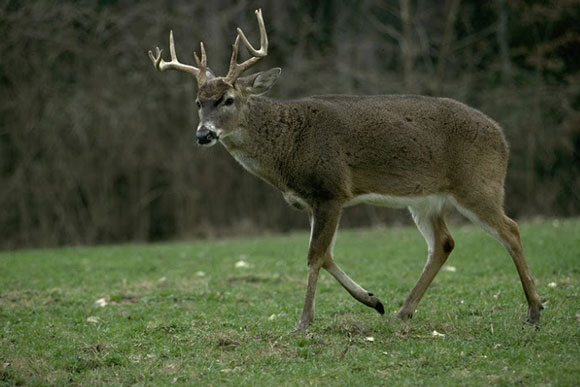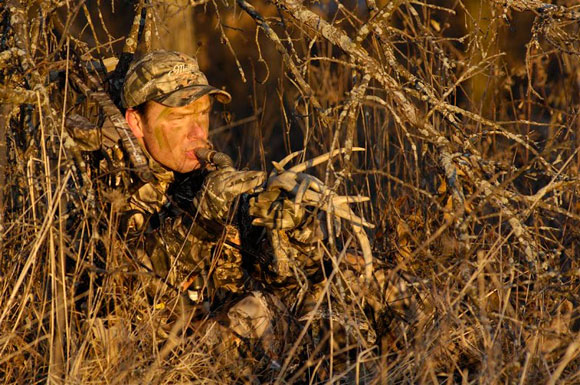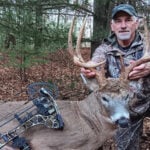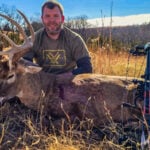LAST UPDATED: May 1st, 2015
One trick many deer hunters now employ to outsmart bucks is the use of deer decoys. Some hunters use buck decoys; others have better luck with doe decoys. Regardless of which one you decide to use, using a deer decoy of some type can put the odds in your favor. The problem is for every bowhunter who has good luck with deer decoys, there is another hunter who has had nothing but bad luck. Knowing when and how to use a decoy can be complicated.
Over the years, I have interviewed many well-known big buck hunters who have had success using deer decoys. Most of these hunters have one thing in common: they live in an area where the buck-to-doe ratio is where it should be in states that don’t receive a ton of hunting pressure. For instance, in Michigan, I know very few people who have had much luck with deer decoys. One of the best known deer hunters in Michigan is Fred Abbas from A-Way Hunting Products. Abbas regularly kills Pope and Young deer which can be difficult here. When I asked him about decoys, he said, “We have experimented with decoys extensively under all field conditions. Ironically, the only times the decoy didn’t make deer nervous were in a deep woods setting. It had a calming effect on them. A decoy by itself in an open field setting made most deer nervous but with soft calling, we were able to convince most bucks to take a closer look, especially the more aggressive bucks.”
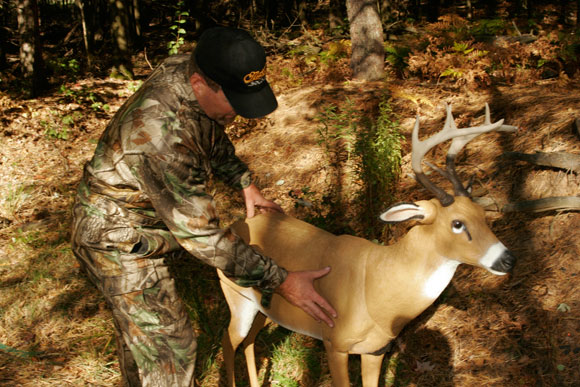
The use of decoys can lead to success if the conditions in your area are right.
On the other hand, many bowhunters I know have had great success when using decoys in open fields. I really think it depends on where you live, the hunting pressure in the area, and the buck-to-doe ratio. The founder of Double Blinds, Brooks Johnson, often uses a decoy in front of his blind to calm deer down. “I have had success putting buck and doe decoys in front of my blind. When a buck sees my decoys, often he pays no attention to the blind,” Johnson said.
Mick Bowman, a Knight & Hale Pro-staffer from Kansas, has great luck with decoys. Bowman hunts mostly private land and in an area where the buck-to-doe ratio is where it should be. He believes the reason many people have problems with decoys is because they use them improperly and don’t pay attention to the little details. “First and foremost, a decoy must be scent-free. Hunters must wear rubber gloves when handling them, spray down the decoy with a scent eliminator and put some type of lure on the decoy: either buck urine or estrus doe.” Bowman also wears scent eliminating clothes and always hunts the wind.
Decoys, like any other piece of equipment you bring in the woods, must be kept as scent-free as possible. Otherwise, it will do more harm than good.
Bowman has the best luck using the decoy in an open field where deer can see the decoy from a distance. In most cases, Bowman sets up a buck decoy. “When does and bucks see a doe decoy, they sometimes come take a look at it. “During the pre-rut and often in the rut, if a big buck sees a buck decoy, he will come running in almost every time. A big buck will not tolerate a buck in his area.” To add realism to the decoy, Bowman often puts tarsal glad lure on the buck. When the buck approaches the decoy, the decoy smells like the real thing. Bowman consistently kills big bucks over decoys. Part of the reason he does it is because he knows how to properly position a decoy to ensure he gets a kill shot. “A lot of hunters will place a decoy facing broadside to their treestand or facing away,” Bowman said. “That doesn’t really work that well. When a buck approaches a buck decoy he wants to square off with it. He often approaches from behind the decoy then comes around to the front. I place my decoy facing my stand. That way as the buck approaches I often end up with a quartering away and broadside shot, giving me ample time to focus on the shot and take it.
Although some folks have good luck using a decoy in the deep woods or thick cover that hasn’t been the case with Bowman. “Deer know there bedroom really well and they are accustomed to things looking a certain way,” Bowman said. “When they come walking around a corner and see a buck standing there sometimes they practically jump out of their skin. When they see it in a field they have time to react to it.” Both Bowman and Abbas like to use calls when using a decoy. Bowman lives in an area where using a snort wheeze call can work great. Abbas who lives in Michigan uses a less aggressive approach. “I use our “Bowgrunter Plus” deer call , we designed it specifically to give a bow hunter total control under any circumstances, plus it is the only patented Social call in the world and 95% of all hunts are done during social situations. As for my favorite setting I like a young buck setting because all deer respond to it and it doesn’t intimidate any of them like a dominant buck setting would be most apt to do.”
You never really know how a buck will react once it spots your decoy; and that is part of the excitement that comes with using decoys.
One reason to use decoys is to get big bucks within bow range. Bowman often uses a decoy because it makes hunting more exciting. He loves watching deer react to the decoy when they first see it. “I’ve seen large bucks come running up to the decoy with the hair on the back of their necks raised, ready to fight. I’ve seen other bucks run up to the decoy and never even stop. They simply plow right through the decoy. I’ve had small bucks come up to it check it out, and act like they are going to charge the decoy even though the decoy was bigger than them; does have also done some crazy things to the decoys. I saw one doe walk up to the decoy, smell it, turn around, and kick the decoy over with her back legs. One thing is for sure: you can always plan on having some action when hunting over a decoy if you do everything right,” Bowman noted. Another thing Bowman suggests hunters try is getting rid of one antler on a buck decoy, cutting off a few points from the antlers or simply using a doe decoy. “Decoys aren’t going to work the same way in every part of the country,” Bowman noted. “In certain parts of the country a 110-inch buck is a big one. In other parts of the country a 150-inch buck is a big buck. If I lived in an area with a lot of small bucks I would either make a buck decoys antlers less intimidating or just use a doe decoy.”
As bowhunters we all know the odds are against us when we enter the woods with a bow in hand. Many of us do what we can to increase our odds of success. When used properly a deer decoy, calling, using scents such as doe urine and gland sent as well as being scent free can increase our odds a little bit. Heck, make a mock scrape near your decoy and it might even increase your odds even more. The bottom line is nothing works 100% of the time but if you work hard and hunt smart a decoy might just be the trick you need to put antlers on the wall and meat in the freezer.
About The Author: Tracy Breen is a full-time outdoor writer, speaker and marketing consultant in the outdoor industry. He works with a variety of companies including Mathews, Mission and Carbon Express. Learn more about him by visiting, www.tracybreen.com.

 By
By 
